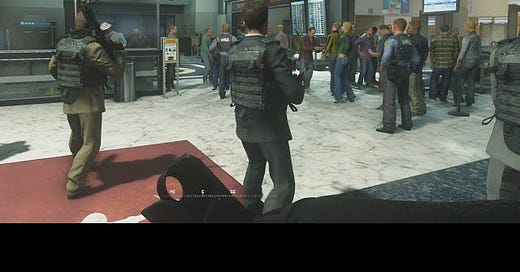Warning: this is long. I originally wrote it for ACX’s “Everything But Books Review” contest. It didn’t make it into the finals, so I decided to write it here.
The three best selling videogame franchises of all time are, in order Mario, Tetris, and Call of Duty. It’s an interesting list, because each of them represents dramatically different visions of what videogames should be.
Mario represents the idea of videogames as light, escapist fantasy. It’s built around lovable, recognizable characters in a brightly colored fantastic world who alternately battle and play with one another. The morality is black and white, the stakes are never particularly high, and the franchise is never too worried to explain why Mario needs to defeat Bowser in combat one game and doubles tennis the next.
Tetris is an abstract puzzle game that comes straight out of the former Soviet Union. It’s the paradigmatic example of videogames as abstract, logical puzzles in the same way that chess or checkers are. There are falling tetrominos (tetra meaning four, and mino from “domino”), and they need to be aligned in a 2d plane by rotating them. The joy of the game comes from shape rotating under time pressure. There are no stories, no characters, and no morals. The only concession to aesthetics is the annoyingly catchy theme song.
Then, there’s Call of Duty. Unlike Mario, a fantastical shell for innumerable types of games, or Tetris, an abstract instantiation of a singular puzzle, Call of Duty is, and has been, an annual, expensive showcase for a “realistic” combat simulator. Each year, millions of Call of Duty players buy the next annual installment so that they can pretend to be grizzled war veterans shooting and being shot by other grizzled war veterans, both computer-controlled and human alike.
Because Call of Duty releases annually, and because it places an emphasis on realism (although never at the expense of fun), it has a unique pressure to be timely in a way that the other franchises do not. In other words, it tries to reflect the world that it was developed in, through the lens of the American developers who guide its development.
The Call of Duty developers have taken this idea of reflection in different ways over the course of the franchise. Some installments of the franchise take this literally, and try to make the plot of the campaign mirror current geopolitical trends with the technology to match. Some installments of the franchise try less to reflect current trends and more to reflect current worries, with narratives of America’s fall and our adversaries’ rise. And many, many installments try to use current sentiments to reflect back on America’s past wars, most often WW2. Never before have so many young men in their basement wasted so much of their time for so little.
All in all, there have been 21 mainstream Call of Duty games, one for almost every year between 2003 and 2024 (2004 being the sole exception). They are an almost continuous, two decade long showcase into how America sees itself in relation to its foreign privileges and obligations, especially its military. It is the single most popular, most commercially successful lens into how America sees itself in relation to the outside world. Given the radical restructuring going on right now of that very subject, it’s worth taking a look back through Call of Duty titles to figure out how we got here.
The first Call of Duty had a simple goal: to make the most atmospheric WW2 shooter ever made. It would be first person; take you on a grand tour of the major WW2 battlegrounds through American, British, and Soviet soldiers; and it would make you feel like you were goddamn Audie Murphy. You’d shoot, throw grenades, lay down suppressive fire, and, unique for the shooters of the time, feel like you were playing a decisive role in massive battles along with your allies. You wouldn’t be a one man wrecking ball like Doom guy or Master Chief, but you would be a hero soldier.
The next two Call of Duty games, appropriately named Call of Duty 2 and Call of Duty 3, were the same but better. In 2, you’d defend Stalingrad as a Soviet private, destroy German tanks in North Africa as a British sergeant, and charge German bunkers as an American corporal. You’d do about the same in 3, but this time as an American private, a British sergeant, a Canadian private, and a Polish corporal in the tank division. Thousands of Nazis would die by your hands by the time the campaigns were done, and your manly comrades would send up virtual cheers for you, assuming they also hadn’t died heroic deaths. Or, you know, you hadn’t accidentally shot them in the back when their AI pathing led them in front of your machine gun.
It was the next Call of Duty, Call of Duty 4: Modern Warfare, released in 2007, that the developers first considered making a more complicated political statement than “it was good and cool that the Allies won WW2”. This probably had something to do with the times. By 2005, when COD4 started development, it was becoming increasingly clear that, despite what George W. Bush had promised, the wars in Afghanistan and Iraq were not going to be savior stories. We were 4 years out from having resoundingly conquered Afghanistan and 2 years out from having conquered Iraq and yet, somehow, the wars were still going on.
Past the paywall I go through the entire rest of the Call of Duty franchise in this lens.
Keep reading with a 7-day free trial
Subscribe to Trevor Klee’s Newsletter to keep reading this post and get 7 days of free access to the full post archives.



